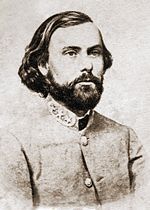12th Texas Cavalry Regiment
Soon after the war started in April 1861, William Henry Parsons, a Waco newspaper editor, began recruiting men for a cavalry regiment.
[2] A number of Texas counties were represented as follows:[1] On 25 March 1862, Earl Van Dorn received an order from Albert Sidney Johnston to transfer his Army of the West to Corinth, Mississippi.
Van Dorn proceeded to shift all available soldiers, ammunition, food, and weapons to the east side of the Mississippi River.
Thomas C. Hindman, the newly appointed Confederate commander in Arkansas, was appalled to find almost no soldiers or military equipment to defend Little Rock.
Before Hindman's arrival, John Selden Roane started to detain Texas cavalry regiments as they crossed Arkansas headed for Memphis, Tennessee.
[1] Before this skirmish, the local Union commander Peter J. Osterhaus reported to Curtis that Confederates and irregulars were harassing his division.
At Whitney's Lane, the Texas cavalrymen surrounded a Union foraging party from the 17th Missouri Volunteer Infantry near Searcy.
[5] Another source stated that 100 troopers of the 12th Texas under Major Emory Rogers plus 50 local militia attacked a group of Union foragers at the intersection of Whitney's Lane and the West Point Road a few miles east of Searcy.
[1] Unable to march to Little Rock due to breakdown of his supply line, Curtis moved his army south down the White River.
[1] On 29 July, the 1st Battalion of the 1st Wisconsin Volunteer Cavalry Regiment led by Lieutenant Colonel Oscar Hugh La Grange reached Marianna on the L'Anguille River.
That same day, the 2nd Battalion of the 1st Wisconsin Cavalry under Major Henry S. Eggleston left Wittsburg with a convoy, heading south, and reached the L'Anguille Ferry near Marianna on 2 August.
Thomas Green took his cavalry division to Blair's Landing to intercept the Federal gunboats and transports as they descended the river.
The Confederate forces claimed to have inflicted heavy losses on Union soldiers in the transports as they passed, but Green was killed by a shot from one of the gunboats.
[16] Thomas Oliver Selfridge Jr., the commanding officer of the monitor USS Osage reported that the Confederates lined the high banks of the river and fired their rifles at the vessels as they passed within 100 yd (91 m).
[18] The 12th Texas continued to harass the retreating Federal troops and fought in the last action of the campaign at the Battle of Yellow Bayou on 18 May 1864.


